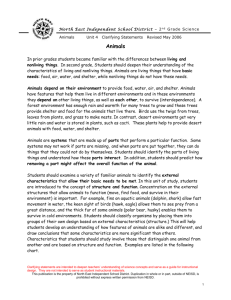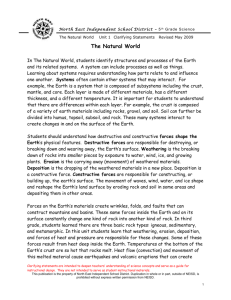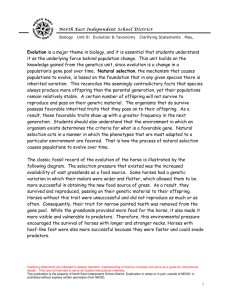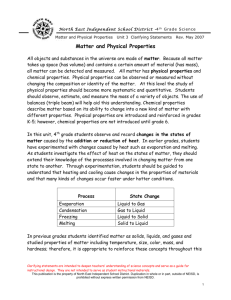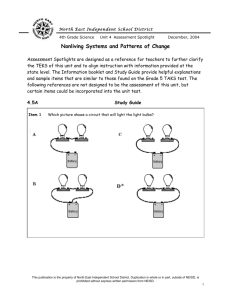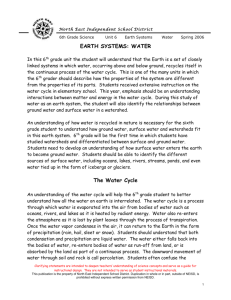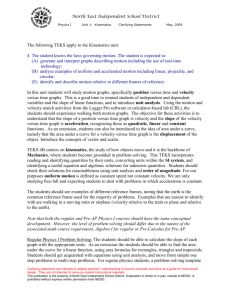8th grade Chemistry & Heat - North East Independent School District
advertisement
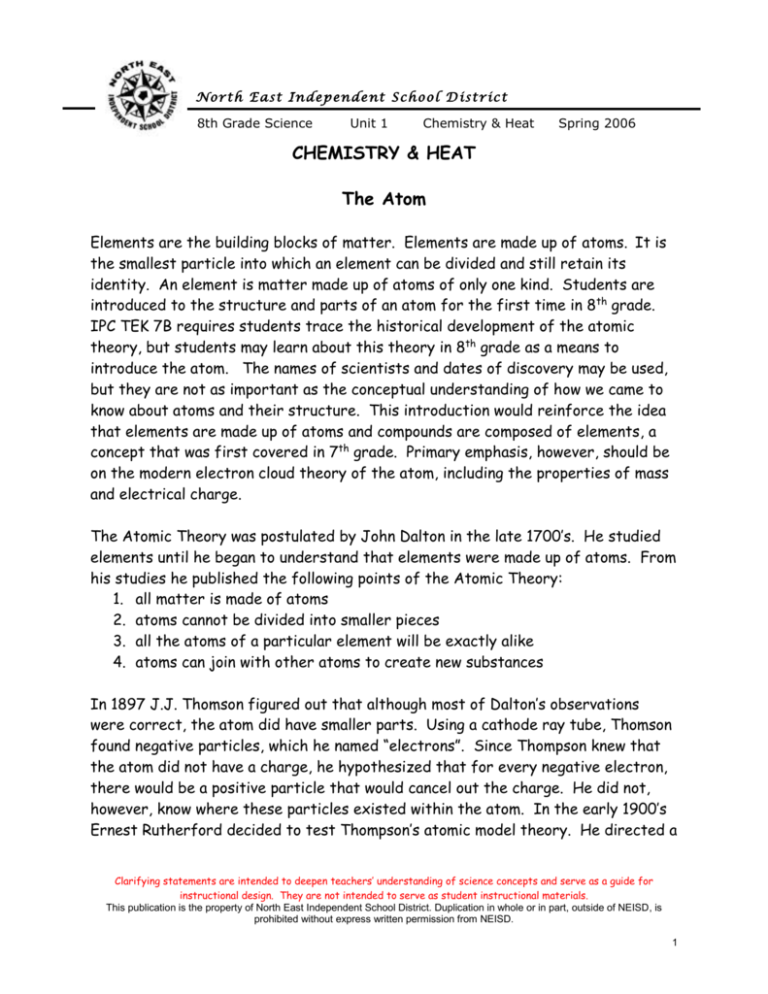
N o r t h E a st I n d ep en d e nt S c h o o l D i st ric t 8th Grade Science Unit 1 Chemistry & Heat Spring 2006 CHEMISTRY & HEAT The Atom Elements are the building blocks of matter. Elements are made up of atoms. It is the smallest particle into which an element can be divided and still retain its identity. An element is matter made up of atoms of only one kind. Students are introduced to the structure and parts of an atom for the first time in 8th grade. IPC TEK 7B requires students trace the historical development of the atomic theory, but students may learn about this theory in 8th grade as a means to introduce the atom. The names of scientists and dates of discovery may be used, but they are not as important as the conceptual understanding of how we came to know about atoms and their structure. This introduction would reinforce the idea that elements are made up of atoms and compounds are composed of elements, a concept that was first covered in 7th grade. Primary emphasis, however, should be on the modern electron cloud theory of the atom, including the properties of mass and electrical charge. The Atomic Theory was postulated by John Dalton in the late 1700’s. He studied elements until he began to understand that elements were made up of atoms. From his studies he published the following points of the Atomic Theory: 1. all matter is made of atoms 2. atoms cannot be divided into smaller pieces 3. all the atoms of a particular element will be exactly alike 4. atoms can join with other atoms to create new substances In 1897 J.J. Thomson figured out that although most of Dalton’s observations were correct, the atom did have smaller parts. Using a cathode ray tube, Thomson found negative particles, which he named “electrons”. Since Thompson knew that the atom did not have a charge, he hypothesized that for every negative electron, there would be a positive particle that would cancel out the charge. He did not, however, know where these particles existed within the atom. In the early 1900’s Ernest Rutherford decided to test Thompson’s atomic model theory. He directed a Clarifying statements are intended to deepen teachers’ understanding of science concepts and serve as a guide for instructional design. They are not intended to serve as student instructional materials. This publication is the property of North East Independent School District. Duplication in whole or in part, outside of NEISD, is prohibited without express written permission from NEISD. 1 N o r t h E a st I n d ep en d e nt S c h o o l D i st ric t 8th Grade Science Unit 1 Chemistry & Heat Spring 2006 beam of positively charged particles through a thin piece of gold. Most of the particles from the radioactive element went straight through the gold sheet, but some of the particles were deflected or bounced back. This would only occur if there were positive particles in the center that were repelling the like-charged particles from the beam. Rutherford came up with a new atomic model which showed a dense nucleus containing positive particles (called protons) and tiny electrons that were around the nucleus. Niels Bohr (1913) further studied the model of the atom and his design showed a dense positive nucleus with electrons orbiting around the nucleus in definite pathways. Twenty years after Rutherford came up with his model of the atom, the nucleus was discovered. The nucleus holds the majority of the mass of the atom, consisting of the neutrons (which have no charge) and the protons (which have a positive charge.) Electrons are so small that their mass does not significantly add to the mass of the atom. Today the model of the atom is called the “electron cloud”. It describes a dense nucleus made up of protons and neutrons with electrons which orbit the nucleus. The electrons do not orbit in direct paths but within clouds or regions of space where they are likely to be found. The movement of the electrons is similar to the motion of fan blades in that they are moving so fast you cannot see them individually. Clarifying statements are intended to deepen teachers’ understanding of science concepts and serve as a guide for instructional design. They are not intended to serve as student instructional materials. This publication is the property of North East Independent School District. Duplication in whole or in part, outside of NEISD, is prohibited without express written permission from NEISD. 2 N o r t h E a st I n d ep en d e nt S c h o o l D i st ric t 8th Grade Science Unit 1 Chemistry & Heat Spring 2006 The following chart is a summary of critical information related to the structure of the atom: Name of particle proton electron THE ATOM Charge of particle Where it is found positive in the nucleus orbiting the nucleus negative Size/mass 1 atomic mass unit almost zero neutron neutral 1 atomic mass unit in the electron cloud in the nucleus The number of protons in an atom is called the atomic number. The number of protons and neutrons in an atom is called the atomic mass. The Periodic Table Students were first introduced to the periodic table in 7th grade. At this level, students described physical properties of elements and identified how they were used to position an element on the periodic table. They recognized that numbers increased from left to right and from top to bottom on the table. They classified elements as metals, nonmetals or metalloids, studied the properties of these categories, and examined the placement of elements within these categories on the periodic table. Periods and groups were terms used to refer to the rows and columns. The 7th grade student did not have an extensive lesson on the periodicity of the table. Atomic number, atomic mass and the concept of valence electrons were not introduced since 8th grade is the first time in which students are exposed to the structure and parts of the atom. It is the 8th grade student that will interpret information on the periodic table to understand that physical properties are used to group elements. The Periodic Table of the Elements that we use today was first created and organized by a chemist named Dmitri Mendeleev in 1869. Mendeleev placed elements with similar physical and chemical characteristics into columns. Mendeleev arranged the elements according to their atomic mass (number of Clarifying statements are intended to deepen teachers’ understanding of science concepts and serve as a guide for instructional design. They are not intended to serve as student instructional materials. This publication is the property of North East Independent School District. Duplication in whole or in part, outside of NEISD, is prohibited without express written permission from NEISD. 3 N o r t h E a st I n d ep en d e nt S c h o o l D i st ric t 8th Grade Science Unit 1 Chemistry & Heat Spring 2006 protons and neutrons). He started with the element hydrogen. He even skipped spaces where an element should be if it had not been discovered yet. Later, as other elements were discovered, they were placed into the table. In the early 1900’s, a scientist name Moseley improved the design of the periodic table and arranged the elements in order of increasing atomic number (number of protons.) This is how the periodic table is arranged today. There have been approximately 115 elements discovered and placed into the modern periodic table. The first 92 elements can be found in nature. Elements 93 on are synthetic, created in a lab. Many of the elements that are man-made are radioactive. The periodic table is not meant to be memorized. The Aug. 2005 TAKS information booklet states “the periodic table will be used as a tool to find information such as element names, symbols, atomic mass, number of protons and neutrons, and the physical and chemical properties of elements.” Based on this statement, it is understood that students need to know the number of protons in an atom of an element can be ascertained by looking at the atomic number. The number of neutrons, however, must be calculated by subtracting the atomic number from the atomic mass. An example is as follows: Lithium is the third element on the periodic table. Its atomic number is 3, indicating it has 3 protons. The atomic mass is 6.941 which can be rounded up to 7. The number of neutrons in an atom of lithium would be 7 – 3 = 4. Students should also understand that the table shows trends and is extremely useful to the study of chemistry. It allows the chemist to have the ability to predict how certain elements will react when joined together. It is recommended that students practice using the table provided on the TAKS formula chart for middle school science. Tables that group elements according to colors change with each textbook and will not be utilized at all on the TAKS test. The TAKS periodic table can be accessed on page 15 of the information booklet with the following link: http://www.tea.state.tx.us/student.assessment/taks/booklets/science/g8e.pdf. A copy of the table is also provided on the following page: Clarifying statements are intended to deepen teachers’ understanding of science concepts and serve as a guide for instructional design. They are not intended to serve as student instructional materials. This publication is the property of North East Independent School District. Duplication in whole or in part, outside of NEISD, is prohibited without express written permission from NEISD. 4 N o r t h E a st I n d ep en d e nt S c h o o l D i st ric t 8th Grade Science Unit 1 Chemistry & Heat Spring 2006 Clarifying statements are intended to deepen teachers’ understanding of science concepts and serve as a guide for instructional design. They are not intended to serve as student instructional materials. This publication is the property of North East Independent School District. Duplication in whole or in part, outside of NEISD, is prohibited without express written permission from NEISD. 5 N o r t h E a st I n d ep en d e nt S c h o o l D i st ric t 8th Grade Science Unit 1 Chemistry & Heat Spring 2006 Each element on the table is represented by a symbol of one or two letters. Rules for writing symbols are: 1) the first letter is always capitalized 2) if the symbol has two letters then the second letter is lower case. For example, S is the symbol for sulfur and Au is the symbol for gold. Each square on the periodic table contains information specific to that element. The following is the key from the table used on the TAKS formula chart, illustrating how this information is provided for students to use and interpret: Students need to understand how the periodic table is organized into periods and groups. A row on the periodic table is called a period. Elements in the same row have something in common -- the same number of energy levels (orbitals). Every element in the top row, period 1, has one energy level for its electrons. All of the elements in the second row, period 2, have electrons in two energy levels; period 3 elements have three energy levels, etc. A column on the periodic table is called a group. Elements in the same group have something in common -- the same number of electrons in their outer energy levels. These outer electrons are called valence electrons. Elements in Group 1 have one valence electron, and elements in Group 2 have two valence electrons. Groups 3 through 12 (transition metals) have a varying number of valence electrons. For Groups 13 through 18, the number of valence electrons is equal to the group number minus 10. The exception to this rule is helium. Helium is in Group 18. Helium atoms have only two electrons, so they have two valence electrons rather Clarifying statements are intended to deepen teachers’ understanding of science concepts and serve as a guide for instructional design. They are not intended to serve as student instructional materials. This publication is the property of North East Independent School District. Duplication in whole or in part, outside of NEISD, is prohibited without express written permission from NEISD. 6 N o r t h E a st I n d ep en d e nt S c h o o l D i st ric t 8th Grade Science Unit 1 Chemistry & Heat Spring 2006 than eight. The following chart shows the pattern of valence electrons for each group: Elements that are classified as metals are found on the left side of the periodic table. The most reactive metals are found in group 1 . This has to do with the valence electrons. The valence electrons can be gained, shared or lost, forming bonds with other atoms. Elements in group 1 are very reactive because they have a tendency to give away their valence electron to an element found on the right side of the periodic table. Elements on the right side are classified as nonmetals. The elements in group 17 are very reactive nonmetals. They need just one more valence electron to fill their outer energy level. The periodic table also contains a dark zigzag (stair-step) line. Elements on either side of this line are called metalloids. Metalloids have some properties of metals and some properties of nonmetals. Students studied the properties of metals, nonmetals and metalloids in 7th grade, but it would be appropriate to review those concepts during this course of study. The chart below reviews the properties of metals, nonmetals and metalloids. The elements that are in the last column are called the noble gases. These elements have enough electrons to fill their outer energy level so they do not react with other elements in nature. Clarifying statements are intended to deepen teachers’ understanding of science concepts and serve as a guide for instructional design. They are not intended to serve as student instructional materials. This publication is the property of North East Independent School District. Duplication in whole or in part, outside of NEISD, is prohibited without express written permission from NEISD. 7 N o r t h E a st I n d ep en d e nt S c h o o l D i st ric t 8th Grade Science Unit 1 Chemistry & Heat Spring 2006 Chemical Reactions The 8th grade student knows that substances have chemical and physical properties. In elementary grades, students were introduced to chemistry through the study of matter and its properties, including state, size, color, mass, hardness, density, and buoyancy. In 5th grade students classified matter based on its physical properties, including magnetism, physical state, and the ability to conduct or insulate heat, electricity, and sound. They also studied mixtures and learned about solutions as a type of mixture. Students were introduced to chemical properties in 6th grade and were asked to classify substances by their physical and chemical properties. They were also introduced to the concept that when a chemical reaction occurs, the new substance formed has its own set of properties. 7th grade focused on identifying everyday examples of chemical phenomena, such as rusting, tarnishing and burning. They also recognized that compounds formed in chemical reactions were composed of elements. In 8th grade the extension is that students are to demonstrate that substances may react chemically to form new substances. In addition, students in 8th grade are first introduced to the concept that these reactions can be represented with the use of chemical formulas and equations. Clarifying statements are intended to deepen teachers’ understanding of science concepts and serve as a guide for instructional design. They are not intended to serve as student instructional materials. This publication is the property of North East Independent School District. Duplication in whole or in part, outside of NEISD, is prohibited without express written permission from NEISD. 8 N o r t h E a st I n d ep en d e nt S c h o o l D i st ric t 8th Grade Science Unit 1 Chemistry & Heat Spring 2006 Substances react to chemically form new substances known as compounds. Clues that can help determine if a chemical change has occurred are production of vapor, light, gas bubbles, a precipitate, odors, and sometimes a color change. The release or absorption of heat may also indicate a chemical change has occurred. A process that produces a chemical change is called a chemical reaction. The substances that one starts out with are known as reactants. The substances that one ends up with are known as the products. Chemical reactions involve changing the arrangements of the atoms. Bonds between the atoms are broken and new bonds are formed. The 2005 TAKS information booklet states “students should understand the basic concept of conservation of mass (mass is neither lost nor destroyed in a regular chemical reaction).” As a result, the 8th grade student will need to recognize the importance of formulas and equations to express what happens in a chemical reaction. Using formulas for compounds is how scientists describe the chemical compounds found in a reaction. Formulas are made of the atoms that compose the compound and the correct ratio is given using subscript numbers. The formula for water is H20. This means that the formula for water has two atoms of hydrogen and one atom of oxygen. Clarifying statements are intended to deepen teachers’ understanding of science concepts and serve as a guide for instructional design. They are not intended to serve as student instructional materials. This publication is the property of North East Independent School District. Duplication in whole or in part, outside of NEISD, is prohibited without express written permission from NEISD. 9 N o r t h E a st I n d ep en d e nt S c h o o l D i st ric t 8th Grade Science Unit 1 Chemistry & Heat Spring 2006 The 2005 TAKS information booklet states “students should be able to recognize the elements that make up common compounds, such as water, sugar, and salt.” The following table lists the formulas students should know at this level: EXAMPLES OF SOME COMMON CHEMICAL FORMULAS Name Formula water H 20 oxygen 02 sodium chloride (table salt) NaCl glucose (simple sugar made by plants) C6H12O6 carbon dioxide C02 Students should also understand that each of the above examples can be referred to as a molecule. Molecules are simply substances with two or more atoms. Chemical equations are used to express what actually happens during the chemical reaction. The equation is read from left to right. The reactants are written on the left side of the arrow. The products are written on the right side of the arrow. The arrow indicates the direction that the reaction is taking place. For example: In photosynthesis: water + carbon dioxide glucose + oxygen Read aloud this reaction would say: water plus carbon dioxide produces (or yields) glucose and oxygen. Using formulas the reaction would look like this: H20 + C02 C6H1206 + 02 Clarifying statements are intended to deepen teachers’ understanding of science concepts and serve as a guide for instructional design. They are not intended to serve as student instructional materials. This publication is the property of North East Independent School District. Duplication in whole or in part, outside of NEISD, is prohibited without express written permission from NEISD. 10 N o r t h E a st I n d ep en d e nt S c h o o l D i st ric t 8th Grade Science Unit 1 Chemistry & Heat Spring 2006 According to the above equation, 2 hydrogen atoms, 3 oxygen atoms and 1 carbon atoms produces 6 carbon atoms, 12 hydrogen atoms and 8 oxygen atoms. This does not support the law of conservation of mass that says matter can be neither created nor destroyed. The number of atoms on the left side of the equation should equal the number of atoms on the right side of the equation. To balance the equation, place a large number in front of the formula to increase all the atoms in that particular formula. The large numbers used in front of a formula is called a coefficient. You multiply the coefficient by the subscript to obtain the number of atoms. If there is no subscript then you multiply the coefficient by one. A balanced equation for photosynthesis would look like this: 6C02 + 6H20 C6H12O6 + 602 Now there are 6 carbon atoms, 18 oxygen atoms and 12 hydrogen atoms on the both sides of this equation, indicating it is balanced. When looking at the above equation, students should also recognize there are 6 molecules of carbon dioxide, 6 molecules of water, 1 molecule of glucose and 6 molecules of oxygen. According to the 2005 TAKS information booklet, students should “focus on identifying rearrangement of atoms” because at this level, they are “not required to balance chemical equations.” The 2006 TAKS Study Guide takes students through the progression of the above concepts using another equation, the formation of tarnish. It also contains sample questions utilizing the equations for the formation of rust and cellular respiration (reciprocal of photosynthesis). Equations of reactions such as these are practical to use since they directly relate to other concepts to which students have been exposed. The reaction for the formation of tarnish (silver sulfide) is as follows: Clarifying statements are intended to deepen teachers’ understanding of science concepts and serve as a guide for instructional design. They are not intended to serve as student instructional materials. This publication is the property of North East Independent School District. Duplication in whole or in part, outside of NEISD, is prohibited without express written permission from NEISD. 11 N o r t h E a st I n d ep en d e nt S c h o o l D i st ric t 8th Grade Science Unit 1 Chemistry & Heat Spring 2006 The reaction for the formation of rust (iron oxide) is as follows: It should be understood that students do not need to memorize the above equations, but be able to interpret them, break them down into their parts (numbers of atoms, molecules, etc.), and explain what is occuring. Everyday Materials The science of chemistry is an amazing field of study. Some chemists study the physical and chemical properties of materials in order learn how to combine them and make new ones. Chemists are also responsible for many of the practical applications once a new material or product has been formed. New compounds have improved lives, and many we take for granted. The table below lists examples of materials we use everyday and their uses. It is not intended to be a comprehensive list or one that should be memorized by students. It is provided as a reference tool. Name SYNTHETIC MATERIALS & THEIR USES How it is made Used For: stainless steel iron + chromium + heat brass copper + zinc + heat pewter bronze lead + tin + heat copper + tin + heat steel iron, limestone (calcium carbonate), coal(carbon) + pans, sinks, tableware, scissors, conducts heat musical instruments such as trumpets, French horns, tubas, light fixtures, statues, etc; conducts heat bowls, figurines, conducts heat tools, statues, gunmetal, awards; conducts heat buildings, tools, ships, bridges, magnets, file cabinets, etc; Clarifying statements are intended to deepen teachers’ understanding of science concepts and serve as a guide for instructional design. They are not intended to serve as student instructional materials. This publication is the property of North East Independent School District. Duplication in whole or in part, outside of NEISD, is prohibited without express written permission from NEISD. 12 N o r t h E a st I n d ep en d e nt S c h o o l D i st ric t 8th Grade Science Name glass Unit 1 Chemistry & Heat Spring 2006 SYNTHETIC MATERIALS & THEIR USES How it is made Used For: tremendous heat silicon, soda ash, limestone + heat paper plant fibers, special machines, chemicals Plastics: nylon chemicals found in crude oil plus additives Plastics: polyethylene chemicals found in crude oil plus additives Plastics: polystyrene (Styrofoam) chemicals found in crude oil plus additive Plastics: bakelite chemicals found in crude oil plus additives Plastics: vinyl (polyvinyl chloride chemicals found in crude oil plus additives conducts heat bottles, all kinds of containers, windows, dishes, decorative objects, light bulbs, eyeglasses; good insulator paper towels, writing tablets, Kleenex, boxes, books, cartons, newspapers & magazines, etc ropes, women’s stockings, parachutes, bristles on a toothbrush; insulator milk jugs, peanut butter jars, squeeze bottles, toys, trash bags, etc; good insulator cups, plates, containers of all kinds, packing supplies; good insulator cooking pots, toilet seats, knife handles, billiard balls; good insulator shower curtains, steering wheels; good insulator Production of new materials created through chemical reactions are used daily. Sometimes the products are discovered accidentally. Spandex, Velcro strips, Kevlar (used to make bulletproof vests), fleece (used in place of wool), artificial turf on a football field, sun resistant clothing are just a few of the newer products made synthetically by the chemical industry. Many failed experiments go into finding the right combination to create new materials that have a useful purpose. Clarifying statements are intended to deepen teachers’ understanding of science concepts and serve as a guide for instructional design. They are not intended to serve as student instructional materials. This publication is the property of North East Independent School District. Duplication in whole or in part, outside of NEISD, is prohibited without express written permission from NEISD. 13 N o r t h E a st I n d ep en d e nt S c h o o l D i st ric t 8th Grade Science Unit 1 Chemistry & Heat Spring 2006 Heat Heat energy surrounds all living things on earth. The Sun gives the planet heat for plants to photosynthesize. Food, when digested, gives the body the heat (or energy) it needs to keep the process of living ongoing. Heat is the transfer of energy between objects of different temperatures. The transfer of heat energy is also known as thermal energy. All matter is composed of atoms and molecules that are moving. Molecules move faster when the temperature increases. The movement of molecules is known as kinetic energy. Heat is always transferred from the hotter object to the cooler one. There are three types of heat transfer: conduction, convection and radiation. Conduction is the transfer of heat through direct contact. A hot sidewalk will warm bare feet through conduction. Convection is the transfer of heat in a fluid through currents. Wind or air masses illustrate this type of heat transfer. Warm or cool ocean currents are another example of convection. Radiation is the transfer of energy or heat as electromagnetic waves. Radiation can occur in outer space where there are no moving molecules. This is the form of energy that brings the heat of the sun to earth. Clarifying statements are intended to deepen teachers’ understanding of science concepts and serve as a guide for instructional design. They are not intended to serve as student instructional materials. This publication is the property of North East Independent School District. Duplication in whole or in part, outside of NEISD, is prohibited without express written permission from NEISD. 14 N o r t h E a st I n d ep en d e nt S c h o o l D i st ric t 8th Grade Science Unit 1 Chemistry & Heat Spring 2006 Specific heat is the amount of energy needed to change the temperature of l gram of a substance by 1o C in temperature. Specific heat is a physical property of a substance just like size, and state of matter. Different substances have different specific heat capacities. In other words, some substances get hot very quickly when exposed to heat while other substances do not rise in temperature very quickly when exposed to the same amount of heat. A higher a substance’s specific heat, the harder it is to increase its temperature. As a result, specific heat can be viewed as the resistance of a substance to change in temperature. In other words, a higher specific heat means that more energy is required to change that substance’s temperature. Students should also relate the property of specific heat to conductivity. Most metals, which are good conductors, have a low specific heat. Most nonmetal compounds, which are poor conductors, have a high specific heat. The following table lists some examples, illustrating this relationship: The high specific heat of water should be noted. This characteristic is important because it helps to maintain the equilibrium of Earth’s climate as so much of our planet is covered in water. Clarifying statements are intended to deepen teachers’ understanding of science concepts and serve as a guide for instructional design. They are not intended to serve as student instructional materials. This publication is the property of North East Independent School District. Duplication in whole or in part, outside of NEISD, is prohibited without express written permission from NEISD. 15 N o r t h E a st I n d ep en d e nt S c h o o l D i st ric t 8th Grade Science Unit 1 Chemistry & Heat Spring 2006 According to the 2005 TAKS information booklet, the 8th grade student does not need to know how to calculate specific heat mathematically. “Students should recognize specific heat as a property of a substance and have a general understanding of how it affects the world around us (including) applications of specific heat, such as why oceans hold heat better than large landmasses.” Loss or gain of heat energy occurs during exothermic and endothermic chemical reactions. Chemical energy is a part of all reactions. During a chemical reaction bonds are either broken or made. When a bond is made chemical energy (usually in the form of heat) is absorbed. The reaction will actually result in a decrease in the temperature of the resulting product in comparison to the temperature of the reactants. This type of reaction is called an endothermic reaction. On the other hand, when chemical bonds are broken, energy is released (usually in the form of heat or light). After it occurs, this reaction either gives off light or produces heat and the temperature rises after the reactants have chemically combined. This type of reaction is called an exothermic reaction. The Law of Conservation of Energy states that energy can neither be created nor destroyed. An example would be the amount of energy given off during an exothermic reaction would equal the amount of energy that was being held in the bonds of the reactants. In some chemical equations, the word “energy” is used in a way to let the scientist know that heat is either given off or absorbed. For example: CH4 + 202 C02 + 2H20 + energy This equation would read: methane gas plus oxygen yields carbon dioxide and water and energy. This is an exothermic reaction because energy is being produced. Clarifying statements are intended to deepen teachers’ understanding of science concepts and serve as a guide for instructional design. They are not intended to serve as student instructional materials. This publication is the property of North East Independent School District. Duplication in whole or in part, outside of NEISD, is prohibited without express written permission from NEISD. 16 N o r t h E a st I n d ep en d e nt S c h o o l D i st ric t 8th Grade Science Unit 1 Chemistry & Heat Spring 2006 Clarifying statements are intended to deepen teachers’ understanding of science concepts and serve as a guide for instructional design. They are not intended to serve as student instructional materials. This publication is the property of North East Independent School District. Duplication in whole or in part, outside of NEISD, is prohibited without express written permission from NEISD. 17
